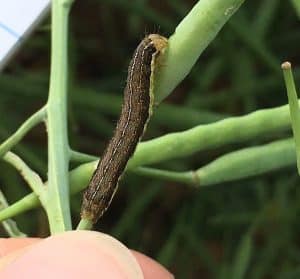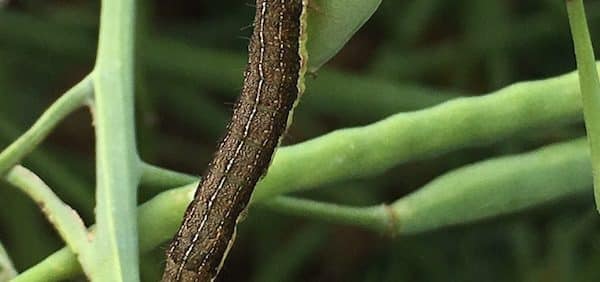A reader from southeast of Saskatoon emailed this question:
I had a field with bertha armyworms on the perimeter in 2017. Numbers were not quite enough to reach spray thresholds, but very close. (I likely should have sprayed the perimeter.) My plans are to seed the field next to it to canola this year. Will this second field likely have a bertha armyworm issue?

Provincial insect management specialists Scott Meers from Alberta and John Gavloski from Manitoba contributed to the answer:
Bertha armyworms (BAW) generally overwinter fairly well, but research out of Manitoba (Lamb et al, 1985*) shows that cold temperatures with very low snow cover can result in high mortality of pupae in the soil. Pupae did not survive a Manitoba winter in snow-free field plots, but 55% survived in plots with 5 or 10 cm of snow.
Scott Meers says seeing BAW in a field but below thresholds can be an indicator for what could be coming for the area (not just the adjacent field) next year. BAW moths are extremely mobile and may or may not lay eggs adjacent to the field they emerge from. There is some indication in the literature that BAW moths preferentially select fields or locations in a field that are in early flower. Natural enemies can change the risk status drastically. Although this sounds like the upswing part of the cycle to me, natural enemies usually are a bigger part of the picture in years two and three of an outbreak. Not spraying when numbers are below threshold is usually the right move. Letting things go will encourage the quicker build up of natural enemies.
For 2018, pencil in a spray when doing crop budgets, be prepared to scout and spray only if thresholds are reached.
*Lamb et al., 1985. Winter survival and outbreaks of bertha armyworm, Mamestra Configurata (Lepidoptera: Noctuidae), on canola. The Canadian Entomologist 117, 727-736.
Further reading:
Canola Encyclopedia chapter on bertha armyworm
Summary of Insects on Crops in Manitoba in 2017

